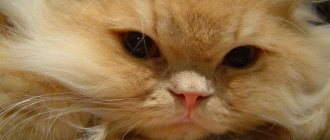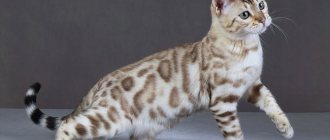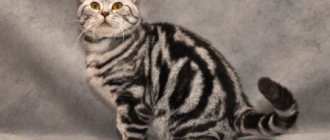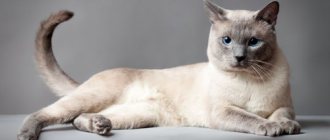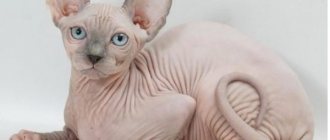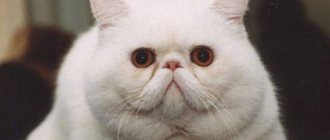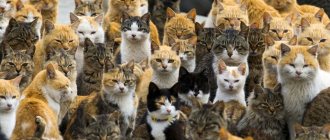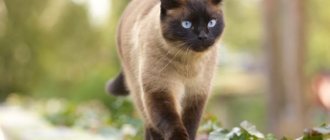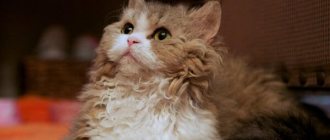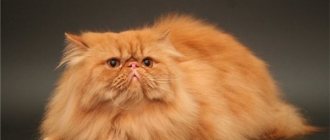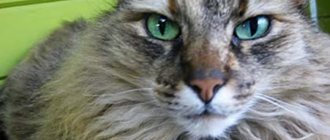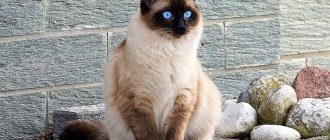- Pets
- >>
- Cat breeds
* Here is a photo of a typical representative of the Oriental cat breed . You can send us photos of your animals by email, and we will post them on the website. Don't forget to send your pet's name.
Other breed names:
Oriental
Video
* We invite you to watch a video about the Oriental cat . In fact, in front of you is a playlist in which you can select and watch any of 20 videos about a given cat breed by simply clicking on the button in the upper right corner of the window. In addition, the material contains quite a lot of photos. By looking at them you can find out what an Oriental cat looks like.
In this article:
|
Rate the material!
[Total votes: 0 Average: 0]
The Oriental cat is an amazing animal that has an unusual appearance. Cats have huge ears, the shape and size of which is unusual for other breeds. Thailand is considered the animal's historical homeland. Such cats can become excellent friends for both children and adults. They are distinguished by friendliness, plasticity, grace and curiosity. Before getting such an unusual pet, it is recommended to study the characteristics of its character and care for it.
Appearance
Aristocrats - purrs with funny big ears - are sophisticated and muscular at the same time. The shoulders and hips are graceful and thin. The neck is long and swan-like. The hind pair of legs is slightly longer than the front ones.
Graceful small oval-shaped paws, flat, toned belly. The tail has a sharp tip, long, thin.
Ordinary representatives of the Oriental breed have short, shiny fur and no undercoat. The hairs are adjacent to the cat's rump over its entire area. The fur grows the largest in the tail area.
The head is not too big, looks like a narrow wedge. The outline of the skull from the graceful line of the nose smoothly expands along two straight lines to delicately sharp large ears.
There are no depressions or other irregularities on the olfactory organ. A long, straight nose crowns a perfectly sharp muzzle (see photo). The lower jawline and nose are located at the ends of one vertical line.
The not too large eyes of these cats are almond-shaped. Most often they are green, planted obliquely and extremely expressive. Today, Oriental cats come in a variety of colors and patterns.
According to color and color types they are grouped into the following categories:
- Tortoiseshells.
- Smoky.
- Bi-color
- Solid.
- Tabby.
- Shaded.
The following colors are available:
- Gray-blue.
- Black ebony.
- Gray with a hint of lavender.
- Brown cinnamon.
- Red-red.
- Chocolate (Havana color).
- Beige (fawn color).
- Cream or light red.
- White.
Tabbies consist of cats with spotted, merle, brindle, silver and ticked colors. White Orientals are considered especially unique.
History of the origin of oriental cats
The historical homeland of this amazing cat is Thailand. The first mention of the mysterious cat dates back to the 13th century AD. They were mentioned in a “collection of poems about cats.” For several centuries, the country's authorities at the legislative level prohibited the export of such exotic animals from the country. In this regard, in other countries no one knew anything about them and had never seen them.
Oriental cats first came to the New World only in the 19th century. In London, a cat and a cat of this breed took part in an exhibition that took place in 1894. However, these cats were disqualified. The description that the exhibition staff compiled about the amazing, unknown animals is still preserved: “representatives of the Siamese breed with a chestnut color and a green iris.” Cats of this breed were considered Siamese and were excluded from participation due to non-compliance with the standard.
A similar situation occurred two and a half years later in England. The organizers of the exhibition excluded the cats from participation due to identical coat color to Siamese cats.
Interesting fact: In the 50s of the 20th century, Baroness Edith von Ullmann and Mrs. Armitage Hargraves decided to breed this breed of cats. It is to these women that cats owe their origin and distribution. The first kittens to be bred were chocolate colored. Then we managed to get blue, beige and all other colors.
To obtain the necessary colors, breeders crossed representatives of Siamese cats with representatives of many other breeds - Russian Blue, Abyssinian. It is noteworthy that ordinary outbred black cats were also used for selection. After the appearance of new flowers, interest in cats began to grow. In 1977, oriental cats were officially registered.
How to choose a kitten
The baby must be purchased from a nursery. Carefully check all documents and the presence of pedigrees. Find out additional information about the nursery, study the nursery website, reviews on third-party resources. You can come to the exhibition and chat with Oriental breeders, learn more about the breed. Cat lovers' clubs often host seminars on breeds, where you can also learn a lot of important things and talk with cat breeders.
If you want an Oriental of a certain color, you may have to wait several months for a certain kitten. Responsible breeders do not give away kittens before 12 weeks.
The cost of a kitten depends on its type . Extreme type kittens are more valuable. The price for kittens starts around 15-20 thousand rubles. A kitten for breeding will cost 50 thousand rubles or more.
Oriental cat - description of the breed
Oriental cats are medium-sized animals. They have sexual dimorphism. Females are slightly smaller and lighter than males. The average body weight of a cat is five kilograms, and cats are 1-1.5 kilos less. Body height at the withers is no more than 32 centimeters.
Representatives of this breed have a unique appearance that cannot be confused with any other. Those who have once encountered oriental cats will forever remember their external characteristics. Breeders and scientists note some distant similarities with Siamese cats.
Main characteristics of Oriental cats:
- A narrow, elongated, elongated body, on which the muscles are quite clearly visible;
- Graceful, thin and fragile neck;
- The head is medium in size, triangular in shape with a pointed muzzle and a narrow chin. The nose area is framed by a long, bushy mustache;
- The frontal part smoothly merges with the bridge of the nose;
- The nose is wide, noble and straight;
- The eyes are large, very expressive, and almond-shaped;
- The iris of the eye is most often colored emerald, in white cats it is sky blue;
- Animals' ears are very large. They are distant from each other, widely spaced, and are, as it were, a continuation of the wedge-shaped shape of the head. The ears are very wide at the base, tapering slightly towards the tips;
- Well-defined muscles in the limbs and chest;
- Athletic, toned stomach;
- Long, graceful, refined limbs. The hind limbs are slightly longer than the forelimbs;
- Paws are rounded;
- The tail is very long and rather thin, with a rounded tip. The tail length of some individuals reaches 80-90 centimeters;
- The animals have rather thick, smooth and shiny fur. There is practically no undercoat.
Interesting fact: There is a type of Oriental cat that is distinguished by the presence of long hair. This breed was bred by breeders from America in the 80s of the last century.
Appearance Features
It is necessary to consider in more detail the character of the Oriental cat and the description of the breed.
Head size is medium. The ears are large, slightly rounded, wider at the base. During exhibitions, a mandatory condition is that their line smoothly continues the line of the wedge of the head. Kittens of this breed experience active ear growth after birth, so at this age they look very funny. But then their growth stops, and as they grow older, this disproportion disappears. The same thing happens with the nose.
The nose of these cats is long and straight. If even a slight snub is observed, this is considered a defect. The nose should follow the line of the forehead.
The eyes of Orientals are almond-shaped; there are no small depressions between them. Some cats of this breed suffer from strabismus, and such a pet will not be registered at the exhibition. The majority of eyes have only green color or have so-called heterogeneity. But if the color is snow-white, then the eyes will be light blue.
The body is stately and graceful. Its elongation and sophistication are observed. The purebred Oriental has strong muscles. The belly is lean. Cartilage appears in the chest area. The hind legs are longer than the front legs.
The weight of a cat is from 6 to 8.5 kg, a cat’s weight is no more than 5 kg.
Popular colors of oriental cats
Like any other breed, the Oriental cat has a standard set of colors. The most common of them is chocolate. Breeders call it "Havana". Cats of this color are completely colored in a pleasant chocolate color, including even the tip of the nose. Only the tips of the paws are slightly different - they are a little lighter.
Other most common colors are brindle, marbled, tabby, and ticked. According to the standard, in addition to the above, other color options for cats are allowed.
Acceptable cat colors:
- Cinnamon. Coat color is light brown. Almost the entire body is painted this color, with the exception of the tip of the nose and the tips of the paws. They are colored light pink;
- Blue. Ash-smoky color, which resembles the color of Scottish cats;
- Faun. The body is painted in an even, solid beige color, the tip of the nose and paws are pale pink;
- Rich red or red. The body is colored red, the tip of the nose and paws are pale pink;
- Lilac (diluted pink, lavender);
- Black;
- White (considered the rarest). Oriental cats have many different colors. They may have a different undercoat color (smoky color), ears, the tip of the nose and the tips of the paws may have a different shade or color.
Quite often, representatives of this breed are confused with Siamese cats. The most common difference is green eyes. Siamese cats' eyes are always sky blue. Deviation from the standards is considered a defect in the breed.
What colors are there?
But there are still a number of most common colors. This:
- Havana. The color is rich brown, evenly colored. In this case, the obligatory condition is that the nose harmoniously matches the overall tone, and the paw pads are colored pink-brown.
- Blue tint. The entire coat should be this color, right down to the tail. Nose also.
- Faun. There should be a combination of beige or light gray wool with pink pads and lobes.
- Lavender. This means that the gray wool has the effect of frost, there is no presence of a blue coating. The lobe and pads should be lavender.
- Ginger colour. Pets of this color have red fur; dark hairs should not be present in it. The pads and earlobe can only be pink.
Character and habits of oriental cats
Oriental cats are very sociable, playful and active animals. They love attention and love to be the center of it. They will constantly demand a lot of attention from their owner, regardless of his busyness and workload. Animals love tactile contact. They love to be on their owner's lap. They will be happy if the owner strokes and caresses them.
Oriental cats are often called “talkers.” It seems that they really know how to talk. The owners note that they accompany almost all their actions with a wide variety of sounds. It is characteristic that animals can pronounce a fairly wide range of different sounds: hissing, grunting, meowing, purring, etc.
Oriental cats are distinguished by their intelligence and intelligence. With them you can learn a wide variety of games and exercises. They are very inquisitive. They are of great interest to the window behind which there is constant movement. Cats can sit by the window for hours and watch what is happening outside. Another trait of animals is curiosity and curiosity. They are incredibly attracted to closed drawers, cabinets, and boxes. They will definitely climb into them to see what is hidden there.
Interesting fact: Oriental cats are incredibly touchy. They inherited this quality from Siamese cats. If someone offends them, they will demonstrate indifference and indifference to their offender, although in fact they will suffer greatly from the offense.
Cats become very attached to their owner. They find it hard to bear his long absence. Animals get along quite easily with other animals, as well as with cats of other breeds, if they grow up with them from childhood. It is unusual for them to show aggression, or to defend and defend their territory too fiercely.
Oriental cats can get along with children quite easily. It cannot be said that they are immeasurably patient with children; rather, they are patient with such family members. They will never offend a child, but they will not allow them to invade their personal space, which is inviolable for them.
Character of Orientals
global $ads_google;
//data-ad-slot=”2475549904″ $ads_google = empty($ads_google) ? false : true; ?> if ($ads_google == false) {?> $ads_google = true; ?> } ?> The sociability of Oriental cats sometimes goes off scale: they strive to comment on everything with a loud, sonorous “meow.” Sometimes it seems that they are simply unable to remain silent.
Animals love attention too much - having an oriental girl and living your own life will not work, now this life will be spent in tandem with a meowing creature.
If you listen to reviews from owners about Orientals, it turns out that cats literally radiate energy: life without movement is impossible for them. After all, you always have to rush somewhere - after toys or people, or after a sunbeam sliding along the wall. Such energy is associated with the pet’s desire to master all the heights in the house: if the owner does not find his kitty, it is worth inspecting the curtains - she is probably swinging on them, climbing onto the cornice.
It’s also impossible to ignore the oriental beauty - oriental cats
touchy.
Interesting facts about oriental cats
Cats have many interesting features:
- Oriental cats are considered hypoallergenic, so they are suitable even for those who are allergic to cat fur;
- Representatives of this breed are called rainbow cats all over the world, as they have a huge number of colors;
- Cats are not able to withstand cold and frost due to their short hair and lack of undercoat;
- Oriental cats are one of the few breeds that have virtually no genetic pathologies;
- Representatives of this breed are long-lived. With good care and optimal conditions they can live up to 20 years;
- Before the breed was officially registered in 1977, its members were called solid coffee Siamese;
- Oriental cats are very demanding in terms of attention. They constantly need tactile contact, organization of games and exciting activities. If they don't get it, they will meow loudly and shrilly;
- Representatives of this breed can be very jealous. It is noteworthy that they can be jealous not only of their beloved family members, but also of a certain place, piece of furniture, or their belongings;
- Among the Oriental breed there may be individuals with strabismus. This pathology is considered a deviation from the breed standard;
- Surprisingly, Orientals almost never use their claws. That is why they will be excellent friends for children;
- Cats are capable of showing incredible devotion, which is unusual even for some dogs;
- It is these cats that are endowed by nature with an amazing timbre of voice, unusual for most representatives of the cat family;
- Some claim that Orientals are telepaths with highly developed sensitivity;
- Cats tend to copy the behavior, habits and mannerisms of their owner. Sometimes it is easier for them to learn to go to the toilet than to go to the litter box.
Tips for choosing a kitten
When purchasing a representative of the Oriental breed, you should consider a number of features:
- do not purchase a pet younger than 3 months;
- check documents to confirm pedigree;
- look at the veterinary passport for information on scheduled vaccinations;
- ask to see the conditions of keeping the future pet;
- pay attention to the exterior of the pet’s parents;
- inquire about the type of feeding of the animal.
When making a choice, observe the kitten's behavior. If he was kept with other individuals, then problems with long-term socialization should not arise. But babies kept in cages will be more wild, so it may take longer to raise them.
The kitten's eyes and ears should be clean, without signs of inflammation. The fur of healthy animals is soft and silky, without tangles or bald spots. All Oriental kittens should look good, lively and not cause discomfort.
Pros and cons of Oriental cats
Oriental cats have a number of undeniable advantages, but they are not without some disadvantages. Before becoming a breeder of such cats, you should definitely study all the pros and cons.
Advantages of the breed:
- Oriental cats have an unusual, very exotic appearance;
- They are very lively, mobile, and incredibly plastic;
- The calling card of the breed is large, triangular-shaped ears;
- Cats are endowed with incredible intelligence and intelligence;
- Animals can sense the desires and mood of their owner even from a distance;
- Representatives of this breed are very sociable, love tactile contact and active games;
- Very affectionate and gentle animals;
- Capable of demonstrating incredible love and boundless devotion;
- Do not require special, complex and labor-intensive care;
- Unpretentious to living conditions;
- Animals have virtually no genetic diseases;
- They are hypoallergenic, making them great pets for those who are allergic to animal dander.
Disadvantages of the breed:
- Animals that are too touchy tend to remember the insult for a long time;
- Sometimes they are truly dependent on their owner and his habits and mood;
- Requires more attention;
- It is necessary to properly organize the animal’s active, active leisure;
- Oriental cats live with the feeling that they are the center of the Universe and the world revolves around them;
- They do not tolerate cold and frost.
Only by assessing all the character traits, animal care, pros and cons of the breed, can you decide whether it is suitable in each specific case or not.
Training and education
Walking an oriental cat on a leash
Orientals inherited from their Thai ancestors a lively, sharp mind and excellent learning abilities. In particular, it is easy to “train” a cat to fetch objects, as well as to carry out simple commands. As for the basics of etiquette, their pet will have to be instilled, because, despite the fairly high level of intelligence, oriental cats are capable of minor dirty tricks. For example, little eared cats love to swing on curtains and dig into flower pots. They do this not out of harm, but out of thoughtlessness, so it is very important to immediately point out to the kitten that such behavior is unacceptable.
Punishing, let alone beating, an animal is the last thing. An Oriental cat can easily guess about its own mistakes, relying only on the intonation of your voice, so use this quality to its full potential. Sternly shout at the mustachioed lawless man walking around the table and hiss expressively at the kitten climbing the curtains. You can be sure that the pet will intuitively understand what they want from him.
A common mistake that can negate the results of all your efforts is periodic exceptions to the established rules. As an example: today a serious reprimand has been given to the kitten jumping on the table, and tomorrow you are filming a video for YouTube where the tiny Cheburashka is briskly climbing the tablecloth to your encouraging comments.
Breeding Oriental cats
The first step is to find a suitable mating partner. To do this, you should carefully study all the information about the potential partner, pedigree, vaccination status, and inquire about their health status.
Experts recommend contacting specialized nurseries, where the chance of finding a purebred representative of the breed is higher. Estrus in females proceeds in the same way as in all other breeds. It is recommended to knit a cat once a year, but not more often than once every six months.
The choice of partner depends on what kittens are needed as a result of the mating. If the owner wants to become the happy owner of show-class kittens, it is necessary to select the same parents. However, even if both parents are show class, there is no guarantee that the same kittens will appear.
If the partners liked each other, pregnancy will occur after mating. On average, it can last from 58 to 70 days. During pregnancy, the cat does not need any special care, except for increasing the amount of food. During this period, it is best to purchase specialized dry food. They contain the maximum amount of minerals and vitamins.
Pregnancy becomes noticeable starting from the fifth week of pregnancy. Preparation for childbirth begins in the eighth week of pregnancy. First you need to give your cat a calm, quiet place where no one will disturb her. Childbirth proceeds in the same way as in other cats and lasts on average from two to six hours. During one birth, from 2-3 to 5 kittens can appear.
Care instructions
Wool
Since Orientals do not have an undercoat, brushing them once a week is sufficient. To do this, buy a comb with low, fine teeth or a soft brush. Start the procedure from the head, in the direction of hair growth, and end with the paws. At the end, run wet hands over the wool a couple of times to remove any remaining fur.
Bathing
Orientals, even longhaired ones, do not need to be bathed often. If the animal gets very dirty, for example, on a walk, it goes without saying. Or a couple of times a year, so to speak, for prevention.
It’s no longer worth it: firstly, this breed is not a fan of water treatments and gets very nervous at the sight and sound of water, and secondly, oriental cats cope well with dirt, diligently licking themselves. Choose a special shampoo: for cats, hypoallergenic.
Human shampoo is not suitable: if a cat swallows it, it will develop severe intestinal upset.
Eyes
But wipe your eyes daily, as discharge accumulates in them. Soak a cotton sponge in fresh chamomile infusion (you can also buy a special lotion: Doctor VIC, Cliny) and gently cleanse the skin from top to bottom.
Ears
Orientals' delicate ears can be easily damaged, so watch your movements. You will need cotton swabs and ear products from a veterinary pharmacy (Veda, Bars, Cliny, Aptus Orisolve).
Teeth
To keep your pet's teeth in good condition, they should be brushed regularly using a special toothbrush and toothpaste. A pet store will help you find the right product. If necessary, a piece of gauze wrapped around your finger can replace the brush.
If your pet doesn’t want to let you approach him with a brush, drop a special cleaning gel into the water, give him more solid food (for a cat on natural food - cartilage, meat in large pieces), cleansing treat pads. And be sure to take your cat to the vet!
Claws
One scratching post is not enough for nail care. Trim them every month by selecting separate tweezers for the animal or by purchasing special nail clippers.
Get your pet used to grooming procedures from a very early age! Be kind and patient, but persistent! Then, over time, it will take a minimum of both time and nerves.
Photo of an Oriental breed cat: long-haired and short-haired
Caring for Oriental cats
Oriental cats do not require special care. Cats must be brushed at least twice a week. They need to be bathed at least twice a month, or more often if necessary.
It is necessary to introduce your cat to bathing procedures from childhood, then adult cats will not be afraid of water. It is necessary to bathe your pet in the absence of drafts, otherwise the pet will definitely catch a cold. Many breeders of Oriental cats recommend drying their fur with a hairdryer from childhood so that the pet does not get scared later.
By nature, Oriental cats are very clean and love cleanliness. They need to keep the tray clean and regularly clean it, because they will never go into a dirty one. The ears need regular cleaning with a cotton pad moistened with water. The ears are treated once a week. The eyes are treated with the same frequency. It is necessary to cut your nails periodically.
Important fact: A mandatory step in organizing cat care is dental treatment. Plaque quickly forms on cat's teeth, which develops into stones, and, as a result, an inflammatory process in the gums.
It is recommended to have your teeth cleaned by a doctor at least once every two years. Experts recommend not leaving animals alone and giving them the maximum amount of free time. Oriental cats do not require much space. They can be safely kept in an apartment and will not feel embarrassed. Animals do not need to be walked outside at all. Sometimes you can take them out on a leash.
Cats must buy toys, as animals like to lead a very active lifestyle. Be sure to buy a scratching post for your cats.
Who is not recommended to have an ori?
You should not have a pet of this breed if you:
- Do you plan for your pet to spend half the day alone while you are at work?
- You don’t have the strength, patience, desire and time to educate an Oriental.
- Don't like cats that are always nearby and prefer those who are on their own.
- You don't like talkative animals; loud noises irritate you, and you prefer peace and quiet.
- Spend part of your time on the road or move frequently.
Diet of Oriental cats
The only thing that will require scrupulousness from the owner is catering. The digestive tract is designed in such a way that cats cannot digest food from the owner’s table. Those who decide to have such a pet have two ways to organize food: feed the animals canned food or dry food.
Interesting fact: Pets prefer canned food, while their owners tend to switch them to dry food, which is considered cheaper and more accessible. In some cases, you can alternate both types of food. However, it is strictly forbidden to mix dry food and canned food in one feeding.
In some cases, it is recommended to treat your cat with delicacies: pieces of raw meat, porridge cooked in milk, selected fish fillets. Too often it is not recommended to pamper your pet with such treats. Firstly, such food contributes to the loss of interest in industrial nutrition, and secondly, this is how animals can become obese.
As a daily source of nutrition, it is recommended to choose the optimal diet so that cats do not want to fill up in reserve. By the appearance of the animal and the condition of the coat, it is easy to determine how balanced and appropriate nutrition the Oriental cat receives. If the coat is shiny and smooth, it means that it is receiving enough food suitable for it.
It is recommended to always leave a little food in the dish so that the animals do not want to eat too much. It is necessary to periodically add vitamin and mineral supplements to the diet. Be sure to have sufficient amounts of calcium and taurine. It is also necessary to ensure daily access to clean water.
Catering
The main requirement for food is its balance.
Recommended food
If you are a busy person, then it will be easier to feed your pet with industrial ready-made food. They are conventionally divided into 4 groups: holistic, super premium food, premium food and economy class.
Holistics
Holistics are more expensive than others, but they are also better in composition. They do not use synthetic preservatives, wheat flour, corn, or vegetable protein ingredients. Contains only the best: fresh and dehydrated fish fillets, meat; peas, rice and lentils as sources of protein, and dried vegetables and fruits as sources of fibre. In addition to the above, there are also vitamin and mineral supplements. Examples of holistic feeds: AATU, Farmina N&D, Now Fresh.
Super premium class
Super premium food is somewhat lower in quality and the price of the product is noticeably lower. Ingredients: a good vitamin and mineral supplement, natural preservatives, while the percentage of meat ingredients is lower, as well as fewer sources of carbohydrates. Examples: Leonardo, Duke's Farm, Pronature Original.
Premium
Advantages of premium food: natural additives; low price; more meat than in cheap analogues; There is food for both kittens and adult cats, as well as for animals with diseases. Disadvantages: rather low meat content; a large proportion of plant components; the presence of dyes and flavors. Examples: Brit Premium, Royal Canin, Pro Plan.
Economy
Economy line food is bought by people who either cannot allocate a certain amount to feed a cat, or who do not know the truth about them. Their only advantage is their low price, but there are many more disadvantages! Firstly, the basis is corn and cereals, and exact descriptions and percentages are not indicated. Secondly, dyes and flavor enhancers are used. And finally, thirdly, these foods are poor in protein.
Below are recommended premium and holistic foods; links with food names are clickable. Using them, you can, within our website, read descriptions of food and read reviews from owners of the Oriental cat breed.
| Super premium | Premium | Holistic |
| Meowing Heads | Science Plan | Carnilove |
Natural products
If your choice is natural nutrition, consider the following.
Orientals love to eat, but are prone to being overweight. The permissible daily calorie intake for cats is 300 kcal, for females – 250 kcal. Babies up to 2 months are fed at least 5 times a day, from 2 to 4 months - 4 times, from 4-6 months - 3 times, over six months - in the morning and in the evening. Food should be at a comfortable temperature: not hot, but not from the refrigerator.
Be sure to include in your diet:
- Beef, lamb or rabbit: 3-4 times a week, 100-120 g;
- Chicken meat: every day;
- By-products (stomachs, heart, liver, chicken necks), minced: 1-3 times a week;
- Fish (trout, cod, salmon, hake, salmon): once a week for cats and 1-2 times for cats;
- Milk (boiled): for kittens up to 3 months, pregnant and lactating cats;
- Egg yolk, whole quail egg: 2 times a week.
- Porridge (rice, oatmeal, buckwheat, wheat): daily;
- Liquid semolina porridge - for kittens up to 3 months;
- Fermented milk products (low-fat cream, cottage cheese, sour cream, natural yogurt, kefir): possible every day;
- Cheese (unsalted): once a week;
- Boiled or fresh vegetables (beets, carrots, cauliflower, cucumbers, green beans): 4-5 days a week;
- Sprouted wheat grains, spinach, salad: 2 times a week;
- Brewer's yeast (dry): 3-4 times a week;
- Vegetable oil (half a teaspoon per porridge): every other day;
- Special supplements with vitamins and minerals: as recommended by a veterinarian.
The cat should always have access to fresh and clean drinking water. Do not pour tap water that is cold or contaminated. Change the liquid 2 times a day: morning and evening.
Oriental cats should not be given:
- Pork, lamb, duck and geese meat;
- Chicken bones, fish bones;
- Sweets: chocolate, marmalade, marshmallows, honey, cakes, etc.;
- Salt, spices, sauces;
- Baked goods (bread, cakes, pastries, etc.); human canned food and sausages;
- Smoked, salty, sweet dishes;
- Potatoes, soybeans, beans (with the exception of asparagus); human vitamins and supplements.
Photo of an oriental breed cat during rest hours)
Diseases and health problems
By nature, Oriental cats are distinguished by good health and strong immunity. However, there is a list of diseases that are most typical for this breed of cat.
List of diseases of oriental cats:
- Gingivitis. Develops as a result of improper oral care. Manifestations of the disease include bad breath, reluctance to eat, and excessive salivation. To avoid such a problem, it is recommended to follow the rules for oral care, use special care products, and also have your teeth cleaned of tartar by a specialist using ultrasound at least once every two years;
- Amyloidosis of the liver. Occurs as a result of malnutrition. Signs of the disease include difficulty urinating and lack of appetite. The fur becomes dull and lifeless. Problems and disruptions in the digestive tract arise;
- Retinal atrophy. There are practically no signs of manifestation. Only a specialist can diagnose pathology during an examination;
- Cardiomyopathy. Heart disease. Animals lose body weight, become lethargic, and have no appetite. The mucous membranes become bluish;
- Flat chest syndrome. Most often, this pathology develops in small kittens. In older animals, it can cause the death of kittens.
Animals are also very sensitive to drafts, which is why they often develop colds.
Diseases
This breed is considered relatively healthy, but Orientals are predisposed to the following diseases:
Cardiomyopathy is a group of non-inflammatory heart diseases. The disease can occur unnoticed by the owners and “come out” only in a stressful (for the animal) situation. The animal develops shortness of breath, vomiting, prolonged weakness, and a drop in temperature. The cause of the disease is not fully understood. Treatment: ACE inhibitors, diuretic, calcium channel blocker. Prevention: high-taurine diet, minimum fat and salt in food, weight control.
Gingivitis is inflammation of the gums around one or more teeth. The cause may be untreated caries, plaque, nutritional deficiencies, viruses, infections, or radiation. The animal's gums turn red, and when pressure is applied to the gums, blood appears. The cat becomes lethargic and irritable and refuses to eat. Her mouth stinks. In severe cases, taking medications, treating the mouth with a disinfectant solution, using ultrasound, or removing a tooth will help.
Liver amyloidosis is a hereditary disease associated with impaired protein metabolism. Mostly older animals (over 7 years old) are affected, but sometimes the disease is also diagnosed in children. Females get sick 2 times more often than males. The cat begins to vomit from time to time, she runs to urinate in the tray more often and drinks a lot, stops eating, and loses weight. Edema and ascites appear. The animal is put on a low-protein diet, and drugs that relieve intoxication are infused into the veins.
Expert opinion
Dusheba Vera Ivanovna
In 2010, she graduated from the Moscow State Academy of Veterinary Medicine named after K.I. Scriabin with honors, specializing in veterinary medicine. I regularly attend veterinary conferences, congresses, and webinars.
Kittens, no matter how smart they are, chew everything indiscriminately. Therefore, make your home as safe as possible: hide chemicals and fragile things, sharp and small objects, secure wires higher (or hide under baseboards). Remove houseplants that pose a danger to them (for example, Dieffenbachia) out of sight. Cover the windows with strong nets to prevent the cat from falling out (mosquito nets will not work!).
